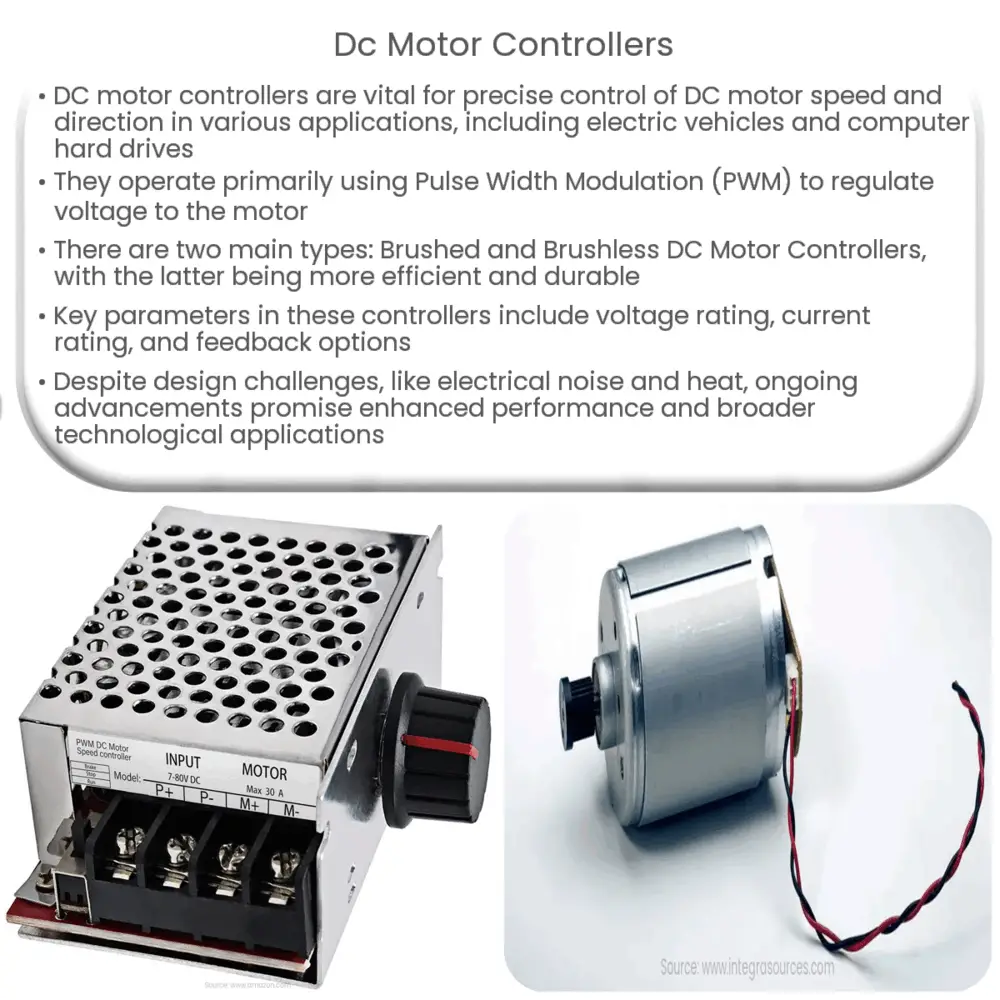Explore the world of DC motor controllers, their operation principles, types, design considerations, and their role in modern technology.

Introduction to DC Motor Controllers
Direct Current (DC) motor controllers form an essential part of many applications in our daily lives, from electric vehicles to computer hard drives, where precise control of DC motors is required. These controllers provide accurate and flexible control over motor speed and direction, thereby improving the functionality of various devices.
Principles of Operation
The underlying principle behind DC motor controllers revolves around the management of voltage supplied to the motor. The primary control method used by DC motor controllers is known as Pulse Width Modulation (PWM). PWM allows the control circuit to “fool” the motor into believing it is receiving more or less voltage than it actually is. This is accomplished by rapidly switching the power supply on and off for varying lengths of time (the “pulse width”), thus controlling the amount of power delivered to the motor and, consequently, its speed.
Types of DC Motor Controllers
Key Parameters in DC Motor Controllers
There are several key parameters to consider when working with DC motor controllers. These include voltage rating, current rating, and feedback options. The voltage rating is the maximum voltage that the controller can handle. The current rating is the maximum current that the controller can deliver to the motor. Feedback options, such as encoder feedback or back-EMF, provide information to the controller about the motor’s actual speed or position, facilitating better control.
In the next part of this article, we will delve deeper into the design considerations for DC motor controllers and explore the role of microcontrollers and other key components. We will also discuss the challenges faced in controller design and how they can be mitigated. Stay tuned!
Design Considerations for DC Motor Controllers
Designing a DC motor controller involves careful consideration of several factors. For starters, the choice of the control method significantly affects the motor’s performance. As mentioned earlier, Pulse Width Modulation (PWM) is often used due to its efficiency and versatility.
Another significant component in the design of DC motor controllers is the microcontroller. The microcontroller acts as the brain of the motor controller, interpreting input signals and translating them into PWM signals to control the motor’s speed and direction. The selection of the right microcontroller, with adequate processing power and relevant features, is crucial for efficient controller operation.
Challenges and Solutions
The design and operation of DC motor controllers come with a few challenges. One common problem is electrical noise, which can interfere with the controller’s operations. This is often mitigated by proper circuit design and the use of filtering components. Another issue is heat dissipation, as controllers can generate significant amounts of heat during operation. Adequate heat sinks and thermal management strategies are necessary to prevent overheating and ensure reliable operation.
The Role of DC Motor Controllers in Technology
DC motor controllers play a pivotal role in many technological applications. From powering electric vehicles to driving robotic systems, their influence is widespread. In fact, advancements in DC motor controller technology often directly contribute to improvements in these fields, underlining the importance of ongoing research and development in this area.
Conclusion
In conclusion, DC motor controllers are a fundamental component of many devices and systems that we interact with daily. They allow precise control over DC motor speed and direction, enabling devices to function efficiently and effectively. Despite the challenges in their design and operation, solutions are constantly being developed to overcome them, leading to improved performance and capabilities. As technology continues to advance, we can expect to see further innovations and improvements in DC motor controller technology, which will undoubtedly contribute to a brighter, more efficient future.

